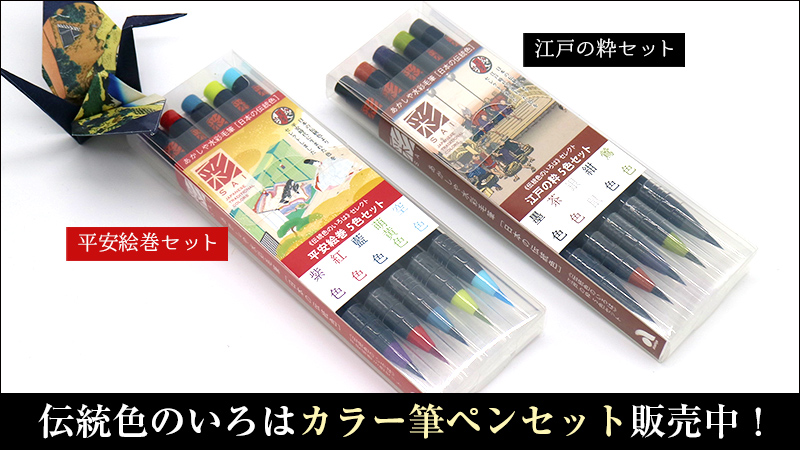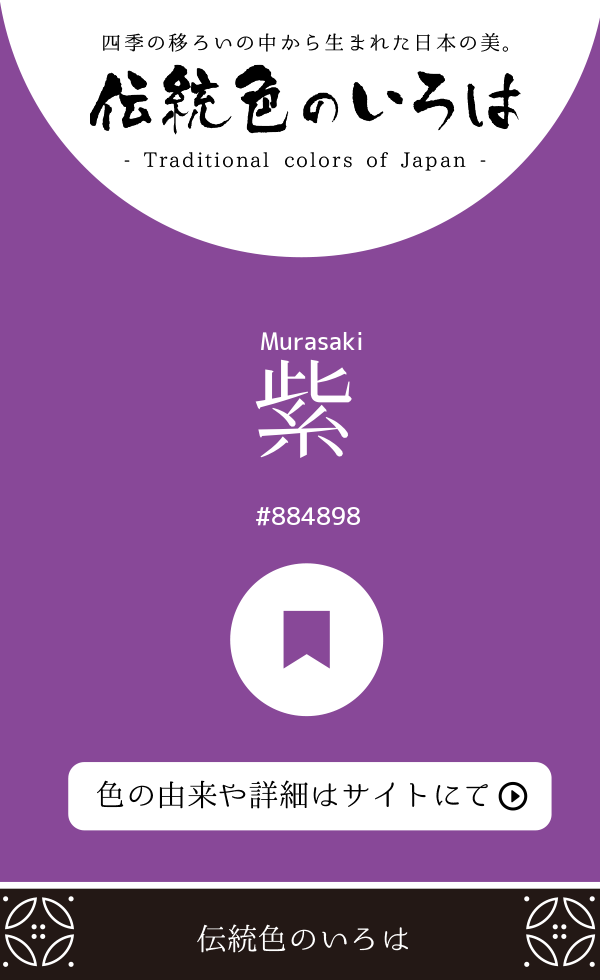| 色の名前Japan Color Name | 紫(むらさき) |
|---|---|
| ローマ字Romanized | Murasaki |
| RGB | R:136 G:072 B:152 |
| CMYK | C:100 M:100 Y:07 K:00 |
| Web カラーHex triplet | |
| 誕辰色 | 1月27日 |
色の説明
紫(むらさき)とは、紫根 で染められた絹のような赤と青の中間の色のことです。または紫系統の色の総称。虹を構成する七色のひとつ。飛鳥時代(五九二〜七一○)にはその名が見られる非常に古い色であり、現代ではJIS規格に定められた基準色でもあります。
名前の由来は多年草の「紫草 」の根(紫根 )で染められたことから、色名も「ムラサキ」と呼ばれるようになりました。
紫草(むらさき)
紫草とは、ムラサキ科ムラサキ属の多年草。初夏から夏にかけて白い花を咲かせる。群れるように咲くことから「群ら咲き 」が名前の由来という。
平安文学にも数多く登場する日本文化を象徴する植物で、乾燥した根(紫根)は生薬や染料として珍重されてきた。近年は絶滅の危機にひんしている。
三代格式のひとつ「延喜式 」では、紫根 の単一染めを『深紫 』と『浅紫 』の二級にわけていますが、この中間にあたる『中紫』が一般的な『紫色』にあたります。
古代より『紫』は宮廷の位階 の色である当色 において上位の色であり、僧侶の最高位を表す「紫の袈裟 」も勅許 がなければ着用を許されませんでした。
平安時代に編纂された歴史書「日本三代実録 」(九○一)には、五世以下で位階五位の皇族“豊前王 ”が禁色である紫の衣を着ていたことを咎められ緋色の衣に改めたと掲載されており、この制度が厳格に守られていたことがわかります。
「法不聽着紫。豊前爲五世五位着紫。爲有司所糺。然後着緋。」貞観7年2月2日条(八六五) :日本三代実録
江戸時代に入ると庶民は紅花染 めの『紅』とともに紫根染 めの『紫』が禁制となりました。そのため安価な染料を使った代用の紫染めを開発し『似紫 』として流行します。市井 の人々もそれほど『紫』を求めていたのでしょう。
ちなみに、『似紫』が流行したため、伝統的な紫根染めは『本紫 』と呼ばれ区別されるようになりました。
いつの時代においても『紫』は人々の憧れの色でもあり、現代でも「紫綬褒章 」のような栄誉ある色のひとつとなっているのも、我が国の紫を尊ぶ文化があるからでしょう。
余談ですが、『紫』は英語では『パープル(purple)』と訳されますが、JIS規格では『紫』と『パープル』は異なる色となっており、伝統的な『紫』は『ロイヤルパープル(Royal purple)』にあたります。

-読み:むらさき-
「紫の我が下紐の色に出でず 恋ひかも痩せむ逢ふよしを無み」作者不明
『万葉集』巻十二・二九七六
関連する色の紹介
- ■紫(むらさき)の由来や色見本
- ■深紫(こきむらさき)の由来や色見本
- ■浅紫(あさむらさき)の由来や色見本
- ■似紫(にせむらさき)の由来や色見本
- ■本紫(ほんむらさき)の由来や色見本
- ■紅色(べにいろ)の由来や色見本
[Explanation of a color]
The Murasaki is a color between silky red and blue dyed with the root of Murasaki (Lithospermum erythrorhizon). Or a general term for colors in the purple family. It is one of the seven colors that make up the rainbow. It is a very old color whose name is found in the Asuka period (592-710), and in modern times it is also the standard color specified in the JIS standard.
The name comes from the fact that it was dyed with the roots of the perennial plant "Murasaki," hence the color name "Murasaki.
Since ancient times, "murasaki" has been the color of rank at court, and "purple vestments," which represent the highest rank of priests, could only be worn with imperial authorization.
In the Nihon Sandai Jitsuroku (91), a history compiled during the Heian period (794-1185), it is written that the imperial family "Toyosaki-ou" were accused of wearing purple, a forbidden color, and changed their clothing to scarlet, indicating that this system was strictly observed.
In the Edo period (1603-1867), the common people were forbidden to use "Beni" (safflower dyeing) and "Murasaki" (purple root dyeing). Therefore, a substitute purple dye using inexpensive dyes was developed and became popular as "Nise-Murasaki". It is likely that the people of the city were also in need of "purple.
Incidentally, since "Nise-Murasaki" (imitation purple) became popular, traditional purple-root dyeing came to be called "Hon-Murasaki" (real purple) to distinguish it from the other dyeing methods.
Murasaki" has always been the color of people's dreams, and it is probably because of our culture's respect for the color purple that it has become one of the colors honored in modern times, such as the "Murasaki Ribbon Medal".
-read:Murasaki-
参考書籍
- 長崎盛輝『新版 日本の伝統色 その色名と色調』青幻舎 ISBN-10:4861520711
- 吉岡幸雄『日本の色辞典』紫紅社 ISBN-10:4879405493
- 内田 広由紀『定本 和の色事典』視覚デザイン研究所 ISBN-10:4881082035
注意事項
表示されている色(RGB値)は色の名前に対するおおよそものです。色名によっては広範囲の色を指す場合や文献・書籍等によっては解釈が異なる場合もありますのでご了承ください。 ご利用の環境によっては、色が適切に表示されていない場合があります。
印刷などに伝統色を利用したい場合は、DICグラフィックス株式会社から発売されている日本の伝統色シリーズがオススメです。
Pinterestでシェアする際にご利用ください。
サイト運営者からのお願い
このサイトが気に入った、役に立ったと思われた方は、Amazon・楽天で買い物をする際はぜひ下記のバナーをタップしてからお買い物をお願いいたします。
こちらからお買い物をしていただきますと、価格の1%相当のポイントがサイトに入ります。もちろんその分、高くなるようなことはありません。
いただいたポイントは今後のサイト運営のための書籍代や運営費、モチベーションにつながりますので、ご協力いただけますと嬉しいです。

 DIC 日本の伝統色 第9版
DIC 日本の伝統色 第9版



